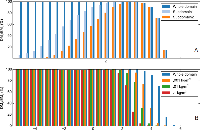Reconstructing eruptive source parameters from tephra deposit: a numerical study of medium-sized explosive eruptions at Etna volcano
Spanu, A., M. de’ Michieli Vitturi, & S. Barsotti (2016)
Bulletin of Volcanology, 2016, 78, 1-19
Abstract
Since the 1970s, multiple reconstruction techniques have been proposed and are currently used, to extrapolate and quantify eruptive parameters from sampled tephra fall deposit datasets. Atmospheric transport and deposition processes strongly control the spatial distribution of tephra deposit; therefore, a large uncertainty affects mass derived estimations especially for fall layer that are not well exposed. This paper has two main aims: the first is to analyse the sensitivity to the deposit sampling strategy of reconstruction techniques. The second is to assess whether there are differences between the modelled values for emitted mass and grainsize, versus values estimated from the deposits. We find significant differences and propose a new correction strategy. A numerical approach is demonstrated by simulating with a dispersal code a mild explosive event occurring at Mt. Etna on 24 November 2006. Eruptive parameters are reconstructed by an inversion using available tephra information collected after the eruption. A full synthetic deposit is created by integrating the deposited mass computed by the model over the computational domain (i.e., an area of 7.5 × 104 km2). A statistical analysis based on 2000 sampling tests of 50 sampling points shows a large variability, up to 50 % for all the reconstruction techniques. Moreover, for some test examples Power Law errors are larger than estimated uncertainty. A similar analysis, on simulated grain-size classes, shows how spatial sampling limitations strongly reduce the utility of available information on the total grain size distribution. For example, information on particles coarser than φ(−4) is completely lost when sampling at 1.5 km from the vent for all columns with heights less than 2000 m above the vent. To correct for this effect an optimal sampling strategy and a new reconstruction method are presented. A sensitivity study shows that our method can be extended to a wide range of eruptive scenarios including those in which aggregation processes are important. The new correction method allows an estimate of the deficiency for each simulated class in calculated mass deposited, providing reliable estimation of uncertainties in the reconstructed total (whole deposit) grainsize distribution.


